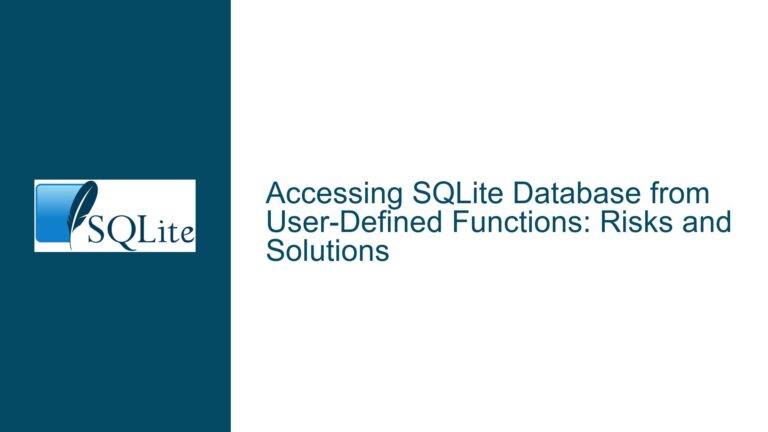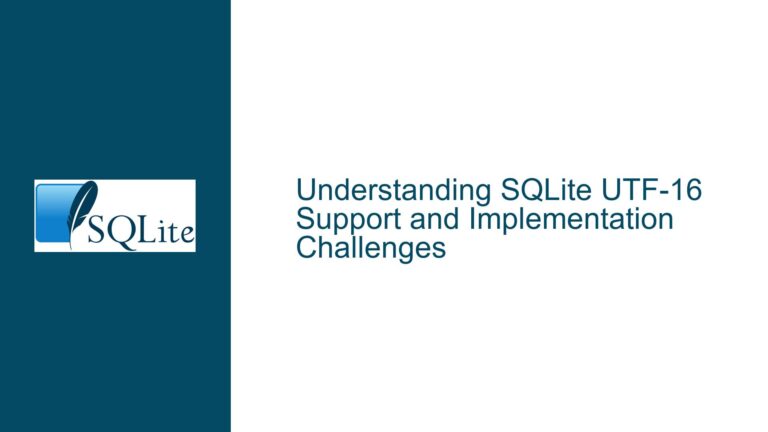Handling UTF-8 Encoding Issues in SQLite with Perl and JavaScript
UTF-8 Rendering Issues in SQLite via Perl DBI and JavaScript
When working with SQLite databases in a web environment, particularly when migrating from MySQL, UTF-8 encoding issues can arise at multiple stages. These issues often manifest when rendering data in web applications, especially when using Perl’s DBI::SQLite module or JavaScript for front-end interactions. The core problem typically stems from mismatched or improperly configured character encoding settings across the data pipeline, from database export to front-end rendering.
In this guide, we will explore the specific challenges of handling UTF-8 encoded data in SQLite when using Perl and JavaScript. We will delve into the root causes of these issues, including potential misconfigurations during data migration, and provide detailed troubleshooting steps to ensure seamless UTF-8 rendering across your application stack.
Misconfigured Character Encoding During MySQL to SQLite Migration
One of the primary causes of UTF-8 rendering issues in SQLite is the misconfiguration of character encoding during the migration process from MySQL. When exporting data from MySQL, the character encoding of the dump file must be explicitly set to UTF-8. If this step is overlooked, the resulting SQLite database may contain improperly encoded data, leading to rendering issues in both Perl and JavaScript.
MySQL’s mysqldump utility does not always default to UTF-8 encoding, and the encoding settings can vary depending on the method used to generate the dump file. For instance, when using cPanel or phpMyAdmin, the default character set might not be UTF-8 unless explicitly specified. This can result in a dump file that contains data in a different encoding, such as Latin1, which will not render correctly when imported into SQLite.
Additionally, the Perl DBI::SQLite module’s sqlite_unicode option, which is intended to handle Unicode strings, may not function as expected if the underlying data is not properly encoded in UTF-8. This can lead to further complications when attempting to render the data in a web application, as the Perl script may misinterpret the character encoding, resulting in garbled or incorrect output.
Ensuring Consistent UTF-8 Encoding Across the Data Pipeline
To resolve UTF-8 rendering issues in SQLite, it is essential to ensure that the character encoding is consistently set to UTF-8 at every stage of the data pipeline. This includes the MySQL dump file, the SQLite database, and the Perl and JavaScript code that interacts with the database.
First, verify that the MySQL dump file is encoded in UTF-8. If you are using mysqldump, you can specify the character set with the --default-character-set=utf8 option. For example:
mysqldump --default-character-set=utf8 -u username -p database_name > dump.sql
If you are using cPanel or phpMyAdmin, ensure that the character set is explicitly set to UTF-8 during the export process. This can typically be done by selecting the appropriate option in the export settings.
Next, when importing the data into SQLite, ensure that the database is configured to handle UTF-8 encoded data. SQLite natively supports UTF-8, but it is important to verify that the data is correctly interpreted as UTF-8 during the import process. You can use the PRAGMA encoding command to check the encoding of the SQLite database:
PRAGMA encoding;
This should return UTF-8 if the database is correctly configured.
In your Perl script, ensure that the DBI::SQLite connection is properly configured to handle UTF-8 data. While the sqlite_unicode option is intended for this purpose, it may not always work as expected. Instead, you can explicitly set the encoding in your Perl script using the Encode module:
use Encode;
my $dbh = DBI->connect("dbi:SQLite:dbname=database.db", "", "", { sqlite_unicode => 1 });
$dbh->do("PRAGMA encoding = 'UTF-8'");
This ensures that the database connection is explicitly set to handle UTF-8 encoded data.
Finally, in your JavaScript code, ensure that the data fetched from the SQLite database is correctly interpreted as UTF-8. If you are using AJAX to fetch data from a Perl backend, ensure that the response is correctly encoded in UTF-8. You can set the Content-Type header in your Perl script to ensure that the browser interprets the response as UTF-8:
print "Content-Type: application/json; charset=utf-8\n\n";
In your JavaScript code, you can use the decodeURIComponent function to ensure that any UTF-8 encoded data is correctly interpreted:
var decodedData = decodeURIComponent(encodedData);
By ensuring that the character encoding is consistently set to UTF-8 at every stage of the data pipeline, you can avoid rendering issues and ensure that your SQLite data is correctly displayed in your web application.
Debugging and Resolving UTF-8 Rendering Issues in JavaScript
Even after ensuring that the data is correctly encoded in UTF-8, you may still encounter rendering issues in JavaScript, particularly when dealing with multimedia content such as audio tracks. This can occur if the JavaScript code does not correctly handle UTF-8 encoded strings, leading to errors when attempting to play tracks with UTF-8 characters in their names.
To debug and resolve these issues, start by verifying that the data fetched from the SQLite database is correctly encoded in UTF-8. You can use browser developer tools to inspect the network requests and responses, ensuring that the data is correctly interpreted as UTF-8. If the data is not correctly encoded, you may need to adjust the Content-Type header in your Perl script, as described in the previous section.
Next, ensure that your JavaScript code correctly handles UTF-8 encoded strings. If you are using a JavaScript library or framework to interact with the SQLite database, ensure that the library is configured to handle UTF-8 data. For example, if you are using jQuery’s $.ajax method, you can set the contentType and dataType options to ensure that the data is correctly interpreted as UTF-8:
$.ajax({
url: "your_perl_script.pl",
contentType: "application/json; charset=utf-8",
dataType: "json",
success: function(data) {
// Handle the data
}
});
If you are still encountering issues, consider using a JavaScript library specifically designed to handle UTF-8 encoded strings, such as TextDecoder. This library can be used to decode UTF-8 encoded strings in JavaScript, ensuring that the data is correctly interpreted:
var decoder = new TextDecoder('utf-8');
var decodedString = decoder.decode(encodedData);
By carefully debugging and resolving UTF-8 rendering issues in JavaScript, you can ensure that your SQLite data is correctly displayed and interacted with in your web application, even when dealing with complex multimedia content.
In conclusion, handling UTF-8 encoding issues in SQLite requires a thorough understanding of the data pipeline, from database export to front-end rendering. By ensuring that the character encoding is consistently set to UTF-8 at every stage, and by carefully debugging and resolving any issues that arise, you can ensure that your SQLite data is correctly displayed and interacted with in your web application.






